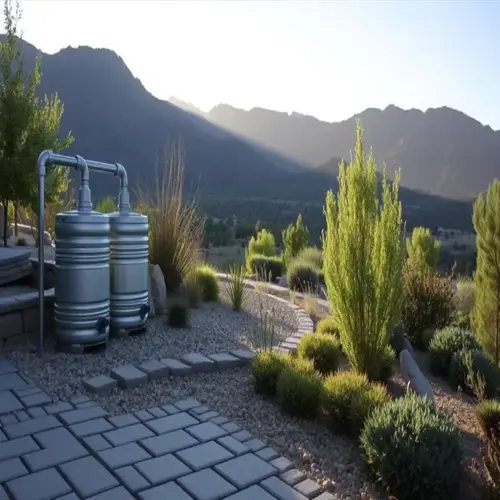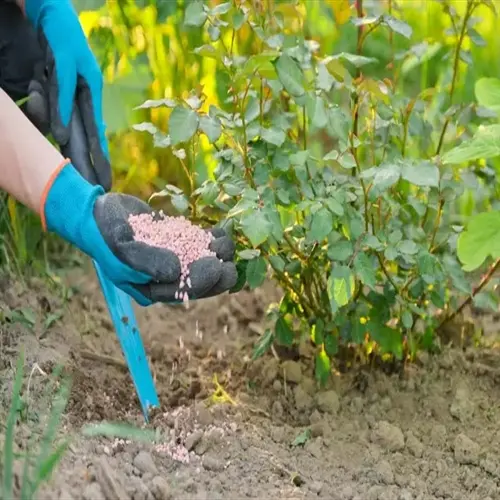When to Harvest Beets: Complete Guide

Written by
Michael Sullivan
Reviewed by
Prof. Samuel Fitzgerald, Ph.D.Determine when to harvest beets by checking root size and leaf indicators.
Baby beets reach peak flavor at 1-2 inches diameter for tender texture.
Mature beets develop optimal texture at 2-3 inches before becoming woody.
Light frost sweetens beets but harvest before hard freezes below 25°F (-4°C).
Check leaf height of 6-8 inches as a visual maturity indicator.
Avoid rigid calendar dates; prioritize soil temperature and shoulder width observations.
Article Navigation
Knowing when to harvest beets makes all the difference for flavor and nutrition. Pull them before their prime and they will be lacking in sweetness. Wait too long and they will become very woody. I wish I had known this during my first season when half my crop was tough and bitter.
Your beets do double duty. The roots will keep well for winter meals, and the greens will provide fresh vitamins right from the garden. They are basically two crops in one plant. That vibrant green canopy reveals a great deal about the root status below ground.
You can accurately identify harvest time with simple observations. Assess root size. Observe the color and texture of the leaves. Record the weather patterns of the season. These are universally accurate measures for any level of expertise. Your next batch will deliver crispy, tender roots to enjoy.
Weather Impact on Timing
Extreme weather changes when you should harvest beets. Light frosts, occurring at temperatures around 28-32 degrees F (-2 to 0 degrees C), naturally concentrate sugar levels. Anything above 80 degrees F (27 degrees C) will cause them to become woody. I protect my crop with row covers when temperatures exceed 85 degrees F (29 degrees C) to shield them from sun scorching damage.
The initial fall frost transforms boring beets into sweet, candy-like roots. Cold air stimulates sugar production as part of the plant's defense mechanism against freezing temperatures. Your thermometer should be used to monitor the temperature closely. If the temperature drops below 25°F (-4°C), the roots will be damaged by freezing and cracking; you must harvest them quickly. This temperature shift is what makes or breaks your crop.
Row covers provide critical protection in extreme weather conditions. You can use lightweight row cover fabric when temperatures are between 75°F and 85°F (24-29°C) for protection against heat stress. You can use heavy frost blankets if the temperature falls below 32°F (0°C). I double layer mine in surprise cold snaps to save the whole harvest!
Location dictates harvest timing. For example, northern gardeners like me wait until the first frosts of autumn to harvest for sweetness maximization. Southern gardeners harvest before the pinnacle of summer heat. Coastal gardeners harvest by humidity change. Whatever your habit, a best practice is to align your strategy with local climate trends.
Spring Planting
- Cool Start Advantage: Spring-planted root crops like beets develop during steadily warming temperatures which promotes consistent expansion without bolting pressure
- Early Harvest Target: Aim to harvest before peak summer heat using the 55-70 day maturity window as baseline
- Moisture Management: Maintain even soil moisture to prevent zoning (color banding) caused by temperature fluctuations
- Soil Monitoring: Insert thermometer 4 inches deep; keep soil between 50-70°F (10-21°C) for optimal growth
Fall Planting
- Frost Utilization: Time plantings so roots reach golf-ball size before first frost for natural sugar enhancement
- Ground Storage: Mulch heavily with straw to insulate roots allowing harvest through early winter months
- Extended Window: Succession plant every 2 weeks from late summer for continuous harvest until hard freeze
- Root Protection: Apply 6-inch straw layer when soil temperatures drop below 40°F (4°C)
Hot Climate Adaptation
- Shade Solutions: Use 30% shade cloth when temperatures exceed 80°F (27°C) to reduce bolting risk in root crops
- Watering Schedule: Irrigate at dawn to cool roots and maintain soil temperature below 75°F (24°C)
- Variety Selection: Choose bolt-resistant types like 'Red Ace' for warmer regions with short springs
- Mulching Technique: Apply 3-inch organic mulch to regulate soil temperature and moisture retention
Row Cover Installation
- Material Selection: Use lightweight (0.5 oz) floating row covers allowing 85% light penetration while trapping heat
- Installation Timing: Deploy when temperatures exceed 75°F (24°C) or drop below 40°F (4°C)
- Securing Method: Bury edges with soil or use sandbags every 3 feet to prevent wind displacement
- Ventilation Protocol: Lift covers during pollination if growing for seeds; remove when temperatures stabilize
Soil Temperature Control
- Monitoring Depth: Measure at 4-inch depth for accurate root zone readings using digital thermometer
- Cooling Technique: Apply pale-colored mulch like straw to reflect sunlight in temperatures above 80°F (27°C)
- Warming Technique: Use black plastic mulch to increase soil temperature by 5-7°F (3-4°C) in early spring
- Critical Threshold: Root crops stop developing when soil exceeds 85°F (29°C) or drops below 40°F (4°C)
Leaf Health Indicators
To evaluate whether or not your beets are ready to harvest, you can measure the leaves. Healthy beet leaves grow 6-8 inches (15-20 cm) long when the roots are about the size of a golf ball. Healthy beet leaves grow 8-12 inches (20-30 cm) long when the beet roots are nearing full maturity. I keep a ruler in the garden to track the growth process.
Be on the lookout for nutrient deficiencies indicated by changes in leaf color. Yellowing leaf edges indicate a boron deficiency. Purple veins suggest a phosphorus deficiency. Brown spots usually indicate a potassium deficiency. These symptoms often develop quickly, and once you notice them, I apply amendments to the soil to correct the issue before its roots become stunted.
Watering is directly related to leaf feel. Temperature and relative humidity also affect the feel of leaves. Very moist soil keeps leaves somewhat waxy and pliable. Limp leaves indicate that you are under-watered. If your leaves feel leathery, then you are overwatered. I check the soil every day at 2 inches (5 cm) to assess the moisture levels.
Examine leaf symmetry or asymmetry for clues to root health. Asymmetric development could indicate crowding or pest infestations, while evenly spaced leaves around the crown may indicate well-balanced nutrition. I typically thin my seedlings to 3 inches (7.6 cm) apart to ensure each plant grows as it should.
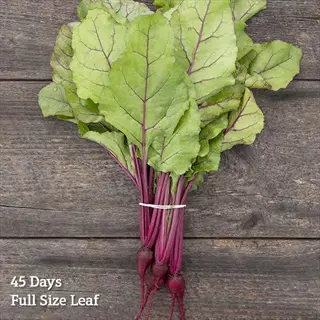
Height Measurement
- Optimal Maturity: 8-12 inch (20-30 cm) leaf height indicates roots approaching harvest size
- Measurement Technique: Measure from soil to tip of longest leaf using ruler
- Baby Beet Stage: 4-6 inch (10-15 cm) leaves signal roots at golf-ball size
- Oversized Warning: Leaves exceeding 14 inches (35 cm) often indicate delayed harvest
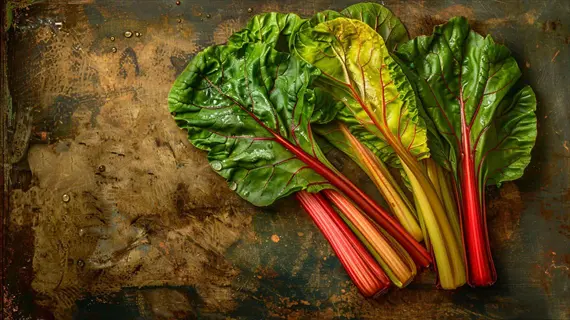
Color Analysis
- Healthy Standard: Deep green with red/purple veins in colored varieties
- Nitrogen Excess: Dark green leaves with undersized roots signal fertilizer imbalance
- Deficiency Alert: Yellow between veins indicates iron shortage; apply chelated iron
- Seasonal Change: Fall foliage may show natural reddening without health concerns
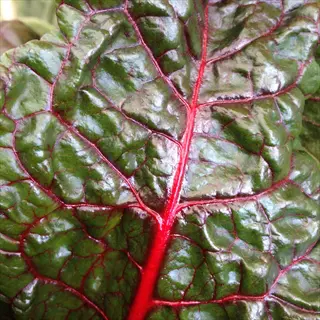
Texture Evaluation
- Optimal Condition: Slightly waxy surface with flexible but firm structure
- Water Stress Sign: Limp or leathery texture indicates inconsistent moisture levels
- Disease Warning: Powdery residue suggests mildew; improve air circulation
- Toughness Factor: Sandpaper-like texture signals over-maturity; harvest immediately
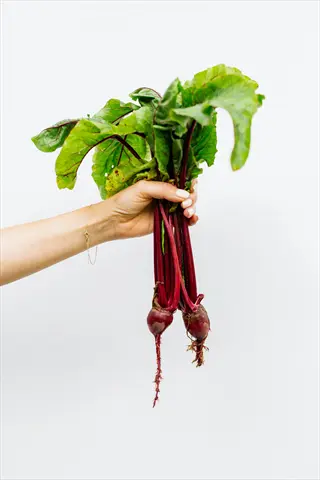
Symmetry Observation
- Healthy Growth: 6-8 evenly spaced leaves radiating from center crown
- Crowding Issue: Asymmetric growth suggests inadequate thinning of seedlings
- Root Damage Sign: Sudden wilting on one side indicates root pest infestation
- Nutritional Balance: Uniform color distribution confirms proper nutrient uptake
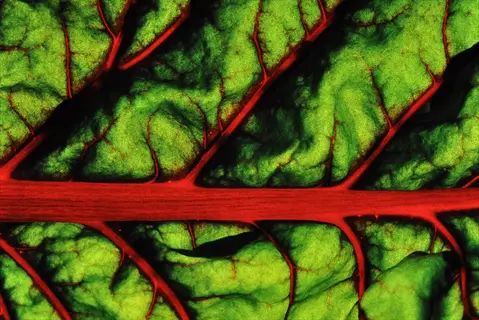
Vein Vitality
- Healthy Standard: Prominent, unbroken veins extending to leaf edges
- Boron Deficiency: Brittle veins with cracked stems - affects root cell development
- Hydration Clue: Sunken veins indicate dehydration; check soil moisture depth
- Disease Indicator: Discolored veins may signal vascular infections; remove plant
Baby Beet Harvesting
For optimum tenderness, harvest baby beets at 1-2 inches (2.5-5 cm) diameter. Their skin will feel silky smooth, while the skin of mature beets has a rougher texture. I always carry a pair of calipers to measure the roots weekly during their 4-inch (10 cm) leaf stage. Pull baby beets when the roots start to show slightly above the soil surface.
To keep your harvest going, sow new seeds every other week when temperatures are around 50-75°F (10-24°C). Plant them 2 inches (5 cm) apart in rows that are 12 inches (30 cm) wide. With succession planting, I have supplied my kitchen nonstop with baby beets from spring through fall.
Unpeeled baby beets have a quicker cooking time and retain more nutrients. Their light skins caramelize beautifully when roasting whole beets. I sometimes throw them raw into salads for crunch and earthy sweetness. The skins have highly concentrated vitamins that are wasted when you remove the peels.
You will discover that baby beets literally melt in your mouth and are far superior to adult beets. They have not yet developed the tough fibers in their cellular structure that their massively developed cousins possess. Steaming maintains that mild, tender texture much better than boiling. I serve them whole, with herbs added, to bring out their organic buttery flavor.
Timing Indicators
- Days After Planting: 35-45 days for most varieties, check seed packet specifics
- Leaf Height: 4-6 inches (10-15 cm) signals baby beet readiness
- Shoulder Visibility: Top 1/4 inch (0.6 cm) of root protrudes from soil
- Texture Test: Skin yields slightly to thumbnail pressure without breaking
Harvest Method
- Pre-Harvest Prep: Water deeply 12 hours before pulling for easier extraction
- Extraction Technique: Grasp leaf base firmly, twist 90 degrees before lifting vertically
- Immediate Processing: Rinse with cold water within 30 minutes to preserve crispness
- Greens Handling: Trim to 1 inch (2.5 cm), store separately from roots
Succession Planting
- Schedule: Sow new seeds every 14 days during 50-75°F (10-24°C) seasons
- Spacing: 2 inches (5 cm) between plants in rows 12 inches (30 cm) apart
- Variety Selection: 'Babybeat' for true mini size, 'Early Wonder' for quick maturity
- Season Extension: Use cold frames for early spring/late fall baby beet harvests
Flavor Optimization
- Sweetness Peak: Harvest morning after cool night for maximum sugar content
- Soil Influence: Sandy soils yield sweeter beets; clay produces earthier flavor
- Cooking Advantage: No peeling needed - skin contains concentrated nutrients
- Texture Preservation: Steam whole instead of boiling to maintain firmness
Storage Guidelines
- Refrigeration: 32-36°F (0-2°C) in perforated bags for 3 weeks maximum
- Freezing Preparation: Blanch whole for 3 minutes, ice bath, vacuum-seal
- Root Cellaring: Not recommended - baby beets lack protective skin thickness
- Greens Usage: Consume within 2 days; more perishable than mature beet greens
Optimal Mature Harvest
Beets the size of golf balls, at 1.7 inches (4.3 cm), have tender flesh and a sweet flavor. Beets the size of baseballs at 2.9 inches (7.4 cm) have a firmer crunch and more earthy taste. I taste-test each of these sizes every year, noticing how the texture changes considerably after 2 inches (5 cm) in diameter.
To gain insight into when to harvest, measure the Shoulder Width at the soil line. A shoulder width of more than 1 inch (2.5 cm) indicates that the black oiler is mature enough to be harvested as a storage variety. Shoulders 0.7 inches (1.8 cm) or less suggest that depth and flavor preference are best eaten fresh. I use a caliper weekly to measure this often overlooked indicator.
Storage capacity fluctuates based on when you harvest. Beets harvested at the size of golf balls will store for 4 months under cool conditions. Roots the size of baseballs will store only 6 weeks before they soften. I harvest larger beets for immediate meals, but save the smaller beets for winter use.
When it comes to harvesting mature beets, the weather is everything. A frost below 32°F (0°C) will sweeten the roots, but a hard freeze will ruin them. Heat over 80°F (27°C) will cause pithy centers. I cover crops (or row cover) during extreme temperatures to keep them safe until harvest day.
Pre-Harvest Preparation
- Soil Moisture Check: Water 24 hours prior if soil moisture below 1 inch (2.5 cm) depth is dry
- Tool Selection: Use garden fork instead of shovel to minimize root damage
- Weather Timing: Avoid harvesting when temperatures exceed 80°F (27°C) to prevent wilting
- Sample Testing: Harvest one test beet per 10-foot (3 m) row to confirm size/texture
Harvesting Technique
- Loosening Soil: Insert fork 6 inches (15 cm) from plant, angle away from root
- Lifting Method: Grasp leaves near crown, pull straight up with steady pressure
- Root Inspection: Check for fork damage; consume damaged beets within 48 hours
- Soil Removal: Gently brush off dirt - never wash before storage
Leaf Management
- Trimming Standard: Cut leaves to 1-2 inches (2.5-5 cm) above crown
- Greens Storage: Refrigerate separately at 32°F (0°C) with damp paper towel
- Usage Timeline: Consume greens within 3 days for optimal nutrition
- Cooking Tip: Sauté stems separately from leaves due to different cooking times
Immediate Post-Harvest
- Curing Process: Shade-dry for 4 hours at 60-70°F (16-21°C) to heal micro-abrasions
- Sorting Criteria: Separate by size - golf ball for fresh use, baseball+ for storage
- Damage Control: Use damaged beets within 3 days or pickle immediately
- Cleaning Protocol: Dry-brush only; moisture invites rot during storage
Storage Optimization
- Refrigeration: 32-40°F (0-4°C) in perforated bags for 2 months maximum
- Root Cellaring: Layer in damp sand at 95% humidity for 5 months storage
- Freezing Method: Cook whole, peel, vacuum-seal for 8-10 month preservation
- Rejection Criteria: Discard beets with cuts deeper than 1/4 inch (0.6 cm)
Step-by-Step Harvest Method
Water the bed thoroughly 24 hours before harvesting to soften the soil around the roots and promote healthy growth. Use a garden fork with 10-inch (25 cm) tines rather than a shovel, to avoid cutting roots. I sanitize mine in a diluted bleach solution to prevent the transmission of diseases from plant to plant.
Place your fork 8 inches (20 cm) away from the base of the plant and angle it away from the roots. Rock it in a gentle motion to loosen the soil within a 6-inch (15 cm) radius of the base. Hold onto the leaves closest to the crown and pull straight up while wriggling the plant on the roots; this will prevent breaking the taproot, which can ruin your chances of storage.
Immediately brush off dirt with a soft-bristle hand brush. Hold the beets upside down to allow dirt to drop off naturally. Examine each root, reject any roots with deep cuts greater than 0.25 inches (0.6 cm). Use sterilized pruning shears to trim the greens to 1.5 inches (3.8 cm) from the crown.
The cure roots on mesh racks in shade for 4-6 hours at 60-65°F (16-18°C). Do not wash the roots, as water can cause rot during storage. If unwashed beets are placed in perforated bags together with a damp paper towel, this will help maintain moisture. Cooling them to refrigeration temperatures below 40°F (4°C) within two hours of harvest will offer the best storage longevity.
Pre-Harvest Preparation
- Soil Loosening: Water garden bed thoroughly 24 hours before harvest to achieve 6-inch (15 cm) deep moisture penetration
- Tool Sanitization: Clean garden fork with 10% bleach solution to prevent disease transmission between plants
- Timing Selection: Harvest during early morning hours when temperatures are below 70°F (21°C) for optimal root crispness
- Sample Testing: Extract one beet per 5-foot (1.5 m) row to confirm maturity before full harvest
Root Extraction
- Fork Positioning: Insert garden fork 8 inches (20 cm) from plant base at 45-degree angle away from root
- Leverage Technique: Gently rock fork back and forth to loosen 6-inch (15 cm) soil radius around beet
- Extraction Motion: Grasp leaves near crown, apply steady upward pull while wiggling root side-to-side
- Damage Prevention: Maintain intact taproot; discard any beets with broken taproots for immediate use
Field Processing
- Soil Removal: Brush off excess dirt using soft-bristle hand brush while holding beet upside-down
- Initial Inspection: Reject beets with visible cuts deeper than 0.25 inches (0.6 cm) or pest damage
- Leaf Trimming: Cut greens 1.5 inches (3.8 cm) above crown using sterilized pruning shears
- Size Sorting: Separate into containers by diameter: under 2 inches (5 cm), 2-3 inches (5-7.6 cm), over 3 inches (7.6 cm)
Post-Harvest Handling
- Curing Process: Arrange beets in single layer on mesh rack in shaded area for 4-6 hours at 60-65°F (16-18°C)
- Cleaning Protocol: Dry-brush remaining soil; never wash before storage to prevent rot development
- Temporary Storage: Place in perforated plastic bags with damp paper towels for transport
- Temperature Control: Move to refrigeration within 2 hours of harvest if ambient temperature exceeds 75°F (24°C)
Tool Maintenance
- Fork Cleaning: Remove soil with stiff brush, rinse under running water, dry completely before storage
- Blade Care: Disinfect pruning shears with 70% isopropyl alcohol after each use to prevent disease spread
- Storage Conditions: Hang tools in dry shed with silica gel packs to prevent rust formation
- Winter Preparation: Coat metal surfaces with food-grade mineral oil before seasonal storage
5 Common Myths
Larger beets always taste better than smaller ones.
Actually, beets over 3 inches (7.6 cm) in diameter develop woody textures and stronger earthy flavors due to increased lignin formation. Optimal sweetness occurs at 1.5-2.5 inches (3.8-6.4 cm), where sugar concentration peaks before fibrous tissue development compromises tenderness and flavor balance in the root vegetable.
Harvesting leaves will reduce root growth.
You can safely harvest up to one-third of mature leaves with no impact on root growth. Beet leaves grow back using axillary buds, and moderate harvesting will improve air circulation. Harvest older outer leaves first, maintaining at least 5-6 healthy inner leaves to provide sufficient photosynthesis for continued root growth. Photosynthesis will not be impacted, resulting in improved yield and quality.
Washing right after harvesting a beet will greatly extend the life of that beet.
Moisture from washing, and washing itself, accelerates spoiling by making the surface of the roots ideal for the growth of bacteria. Thus, one should dry-brush off the soil protecting the thin skin layer as much as possible. Washed beets will spoil 3x faster than unwashed beets. Instead of washing directly, simply use proper curing, in a dry shaded area, for approximately 4-6 hours and refrigerate. This helps to heal micro-abrasions as well as to trap moisture in the beets.
Beets need to be harvested before any frosts happen.
Light frosts at temperatures between 28-32F (-2 to 0C) will induce accumulation of sugars as an antifreeze, producing additional sweetness without disrupting cell structure. Beets also survive temperatures down to 25°F (-4C) if well mulched. Only hard freezes below 25°F (-4C) cause ice crystals that form within cells and disrupt cell structure and textures.
The maturity dates listed on seed packets is the optimal time for harvest.
These dates are based on ideal conditions, that will rarely happen in your garden. The date for maturity can vary from 10-20 days, based on several factors. These factors include a change, either above 70 °F (21C) or below 50 °F (10C), in soil temperature, a difference in sunlight exposure (even more 30%), and differences in nutrient availability. Always use physical indicators, like shoulder width, rather than calendar days for optimal results.
Conclusion
Perfect beet harvesting integrates size checks, leaf observations, and weather to monitor. Throw away schedule dates that don't take into account your individual garden situation. I learned this the hard way by losing crops due to an early frost, even when I followed the 'goal' harvest date given to me. Your plants will show you otherwise.
Observation is always better than a schedule. Calendar-based harvesting can misalign with the optimal flavors. Instead, observe the leaves changing color, and gently push down on the soil to feel the firmness of the roots with your fingers when harvesting. Look for temperature changes. These real-time indicators don't lie.
Precision agriculture gives you a variety of textures and flavors. Baby beets are small and delicate, melty and tender when harvested small. As the beet matures, it develops an earthy, rich depth as it grows to baseball to softball size. Both varieties provide the highest level of nutrition when pulled at their freshest times.
Relying on your senses more than a printed schedule is key. Your fingers can identify firm roots. Your eyes can see the perfect leaf color. Your taste buds can identify peak sweetness. Next season, let the plants guide you in the timing of your harvest. You will be able to taste the difference in each bite!
External Sources
Frequently Asked Questions
How do I know when beets are ready to harvest?
Check these key indicators for beet maturity:
- Root diameter between 1-3 inches (2.5-7.6 cm) depending on preferred size
- Leaf height reaching 6-8 inches (15-20 cm) above soil
- Distinct shoulders visible where root meets soil surface
- Firm texture when gently squeezed without woody hardness
What happens if beets stay in ground too long?
Over-mature beets develop undesirable characteristics including woody texture, excessive earthy flavor, and internal fibrous rings. The roots become increasingly tough as lignin develops, while cracked surfaces may form. Heat exposure accelerates this deterioration, especially above 80°F (27°C), making timely harvest crucial for quality.
How should harvested beets be stored?
Proper storage involves multiple steps:
- Dry-brush soil without washing to preserve protective skin
- Trim leaves to 1-2 inches (2.5-5 cm) above crown
- Cure in shaded area for 4-6 hours before refrigeration
- Store at 32-40°F (0-4°C) in perforated bags for 2-5 months
Can weather conditions affect harvest timing?
Temperature significantly impacts harvest decisions. Light frosts between 28-32°F (-2-0°C) enhance sweetness but hard freezes below 25°F (-4°C) cause cellular damage. Heat above 80°F (27°C) triggers bolting and woody texture development. Always use row covers during temperature extremes to protect roots.
What are signs of premature beet harvesting?
Prematurely harvested beets display underdeveloped shoulders and diameters below 1 inch (2.5 cm). The roots feel extremely soft when squeezed and lack characteristic sweetness. Baby beets intentionally harvested early should still reach golf-ball size with established leaf growth indicating sufficient sugar accumulation for proper flavor development.
Do beet leaves indicate root maturity?
Leaf health directly correlates with root development. Vibrant green leaves at 6-8 inch (15-20 cm) height indicate active photosynthesis supporting root growth. Yellowing edges suggest nutrient deficiencies affecting root quality, while wilted foliage signals dehydration causing tough texture. Always inspect leaves before harvesting.
How does size impact beet flavor?
Flavor profiles evolve with root size. Baby beets under 2 inches (5 cm) offer delicate sweetness and tender texture. Medium beets at 2-3 inches (5-7.6 cm) develop balanced earthy-sweet notes. Large beets over 3 inches (7.6 cm) become increasingly fibrous with pronounced mineral flavors requiring longer cooking times.
Should beets be washed immediately after harvest?
Avoid washing beets immediately after harvest. Moisture accelerates spoilage by promoting bacterial growth on root surfaces. Instead, dry-brush soil while preserving the thin protective skin. Cure roots in shaded, well-ventilated areas for several hours before refrigeration to heal micro-abrasions and extend storage life significantly.
What temperature damages beet crops?
Beets withstand light frosts down to 28°F (-2°C) but sustain irreversible damage below 25°F (-4°C) when ice crystals form. High temperatures above 80°F (27°C) cause bolting, woody texture, and white internal rings. Soil temperatures below 40°F (4°C) dramatically slow root development, delaying maturity.
Can leaf harvesting affect root growth?
Moderate leaf harvesting has minimal impact when done correctly. Remove only mature outer leaves, leaving 5-6 young center leaves intact to sustain photosynthesis. Harvest no more than one-third of foliage at once. This practice actually improves air circulation while allowing continued root development if sufficient foliage remains.
